The gaming industry has always been dynamic and rapidly developing. Soaking up all the latest technological advances like a sponge, it opens up opportunities for gamers to have a gaming experience that was previously only dreamed of. However, this year, the usual pace of deployment of technological innovations, the sequential displacement of the centers of influence on the market, and hot inter-genre battles received an unexpected shake-up.
Deepening into technology and the virtual world has turned out to be much faster than we could have imagined a year ago. The gaming industry received an additional boost, which became decisive for the formation of new technological trends. Therefore, we have decided to take stock of an unpredictable year and highlight those upcoming trends that seem most obvious in the light of what is happening in the current gaming market.
2023 is Over – Long Live 2024
The sudden emergence of the pandemic in 2020 has seriously shaken the gaming sector. People began to spend more time at home, and video games became the number one entertainment.
In 2022-2023, the accelerated virtualization trend has continued.
Now the gaming markets are growing at a tremendous pace, and new games are springing up like mushrooms after a rain.
As a result, by the end of 2023:
- The console games market generated $51.8 billion (-4.2% YoY) with 603 million players.
- The mobile games market generated approximately $92.2 billion (-6.2% YoY) in revenue with 2.675 billion players.
- The PC games market generated $40.4 billion (+1.8% YoY) with a loyal army of 1.045 billion players.
The mobile market remains dominant in terms of revenues. It is followed by the console, and the PC closes the top three.
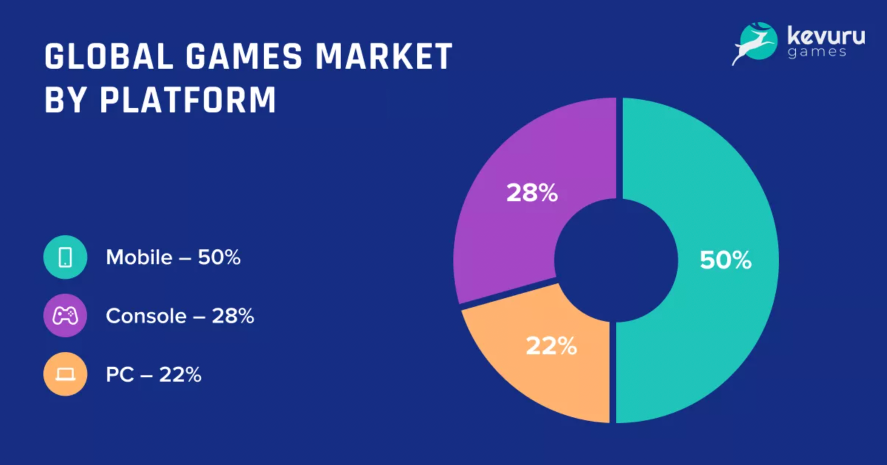
The constant search for new ways to attract and retain customers forces companies to move forward, keeping up with innovations and the waves of gaming trends. Those gaming trends that call themselves new are often not entirely new: many of them are already known to us. But when they rise to the top, it makes you look at them with different eyes.
Chaotic and unpredictable 2022 is over, so it makes sense to look forward to a new stellar gaming period.
Controlled Digitalisation Zone: The State of the Entertainment Industry Before the Pandemic
Although the coronavirus storm is over (sort of), its impact on the gaming industry is too big to ignore. So let’s go back a little.
The coronavirus pandemic has put billions of people under house arrest, and they’ve got plenty of free time. But the leisure industry was not quite ready for this, and digitalization had to be implemented on the go.
The global entertainment and media industry entered 2020 with an alarming awareness of a growth cap.
Back in the fall of 2019, the consulting agency Accenture released an overview of this market, which became a kind of warning. The growth in operating costs outstripped revenue, and the decline in business margins was perceived as a harbinger of an imminent crisis in the media market. To get out of this situation, the authors of the report suggested that market participants combine three tactics:
- Simplify all current operating models and make business processes more efficient to reduce unnecessary costs.
- Ensure zeroing of the annual budget to stabilize the cost scheme and improve money saving activities.
- Invest in business digitalization like AI and intelligent advertising to boost sustainability and increase long-term savings.
A key challenge for Accenture analysts was to draw up a clear plan for the company’s digitalization and define its model: whether it be a cross-platform, vertically integrated, or fully digital service.
For their part, experts from the World Economic Forum (WEF) note that the entertainment and mass media industry has gone through several digital transformations over the past 20 years. In total, they count 4 such waves:
- The emergence and development of file-sharing systems in the mid-1990s.
- The emergence of the first video streaming services in the early 2000s.
- The growth of mobile traffic and the development of cloud technologies in the late 2000s.
- The introduction of the Internet of Things and entire ecosystems around the information provider.
We are now living in a fourth wave era: technology is advancing faster than ever.
However, new generations of consumers demand the most personalized information. Digitalization is so important today that the line between media and technology has become blurred. This is a challenge for both traditional sources of information and fully digital startups.
Given that gigabits of content appear on the Internet every second, the media business is forced to be in the field of consumer attention, WEF analysts write. In the future, they say, the entertainment industry will be defined by 3 main trends:
| Personalization | Fragmentation | Partnership |
| Addressing directly to the consumer as a person in the conditions of his or her information overload. | Spreading content across all possible distribution channels: forums, social media, external sites, etc. | Formating flexible teams in the market, specializing in one business, and uniting to create a unique product. |
Then, out of the blue, an unexpected new player entered the arena: the COVID-19 pandemic.
Impact of COVID-19 on Media and Gaming Trends
The above-mentioned WEF study was prepared in 2015, and little has changed in the market since then. The entertainment industry needed a big push for digital transformation, and it got it.
The coronavirus pandemic swept the world in the first months of 2020, forcing many governments to take unprecedented measures at the cost of disrupting economic life: billions of people were ordered to stay at home for weeks. Many recluses suddenly got a lot of free time, which radically changed the structure of information consumption.
During the quarantine period, all types of offline activities were partially transferred online, but some were canceled. The closure of clubs and cinemas, the rescheduling of concerts and sporting events, even those events that most people could safely watch on TV from home, simply could not take place due to the self-isolation regime.
And the point is not the lack of digitalization, but the very nature of these events. The same attempts to hold the football championship without spectators in the stands eventually ran into tougher quarantine measures. Most of the events were canceled or rescheduled for the next year.
Games became an extremely successful alternative to movies and TV shows for people locked within four walls.
The boom in online multiplayer games, which became an important communication bridge between disconnected people, led to the growth of the battle royale genre and, in particular, Fortnite from Epic Games.
From January 1, 2020, to August 13, 2020 – the day Fortnite was removed from the App Store and Google Play due to disagreements with Apple – Epic’s battle royale ranked fourth in revenue of these games globally, collecting about $ 290 million. Looking at App Store sales alone, Fortnite came in third with nearly $280 million, behind only PUBG Mobile and Knives Out.
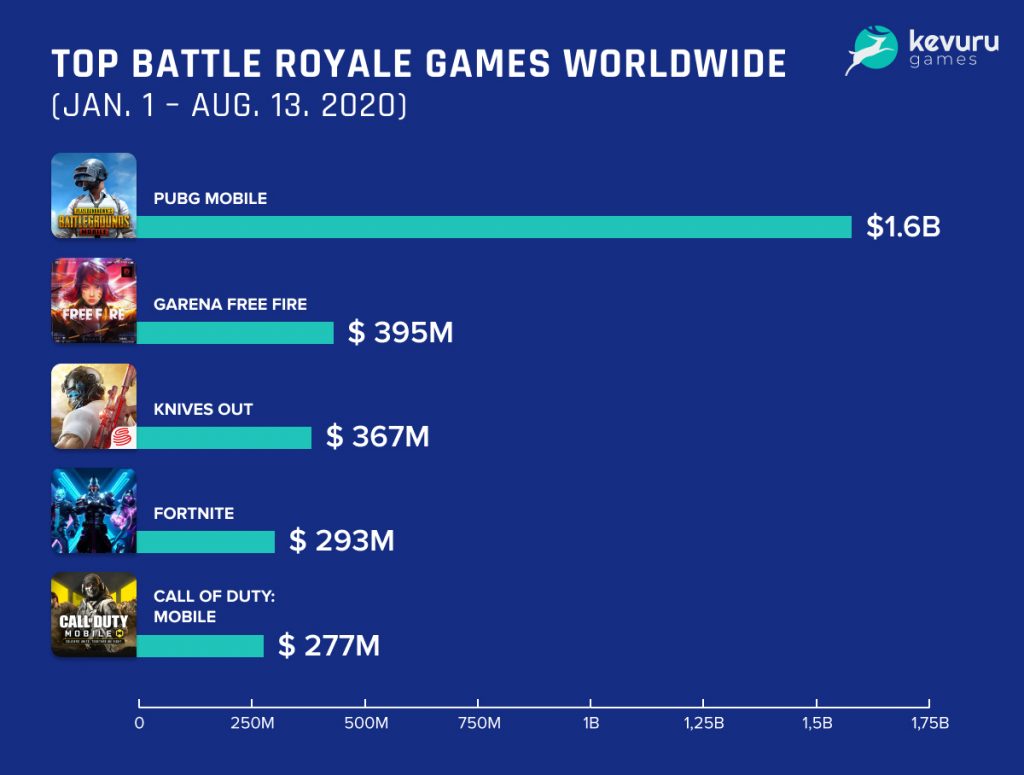
The Kevuru Games team is proud to say that we have also set our hand to promoting Fortnite and attracting more players to it. One of the points of their particular interest is skins, that is, the appearance of the character for the next game session. Despite the fact that the game is free and in-game currency can be obtained without any real investment, just by entering the game every day or completing tasks, many people prefer to speed up the procedure and buy their favorite skins and additional items for them: weapons, bags, backpacks, and even pets.
Our artists created about 120 unique concept art skins for this mega-popular game. Many of them became top-notch. Players shoot video reviews with them, admire the harmony of the image, and even make a cosplay of the most beloved ones.
Game Design Trends Transforming the Entertainment Market
According to Statista forecasts, in 2023, the number of players could reach 3.3 billion.
A player is anyone who has played games on a PC, console, or mobile device in the last 6 months.
| Year | Players | Annual growth | Annual growth, % |
| 2020 | 2.879 billion | +170 million | ↑ 6.44% |
| 2021 | 3.057 billion | +150 million | ↑ 5.34% |
| 2022 | 3.198 billion | +130 million | ↑ 4.39% |
| 2023 | 3.328 billion | +130 million | ↑ 4.21% |
| 2024 | 3.458 billion | +100 million | ↑ 3.11% |
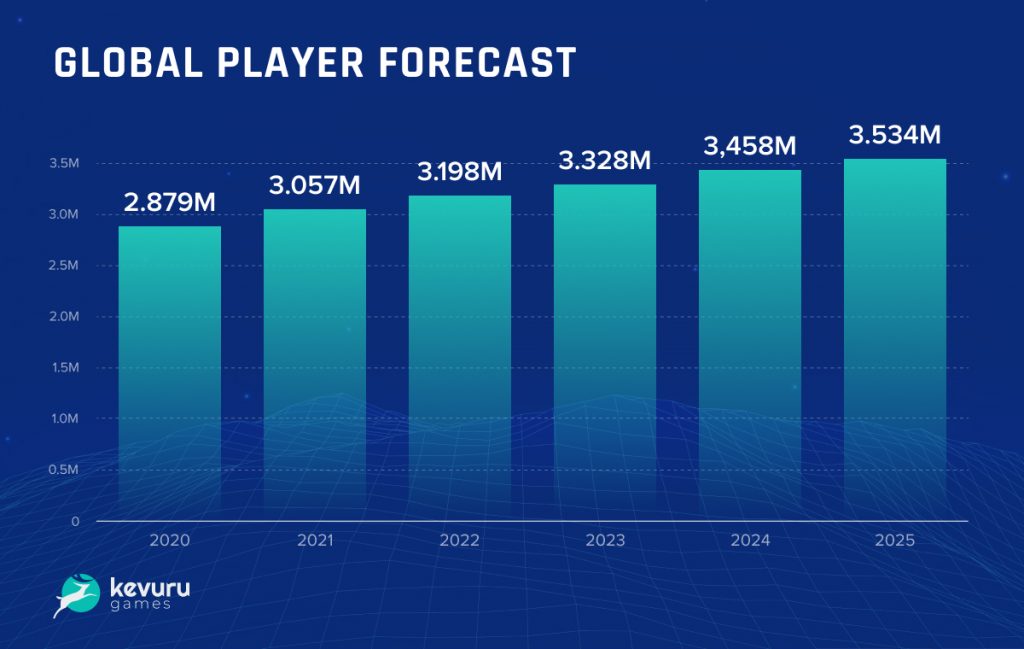
- Most of the players (55%) are from Asia – about 1.746 billion (+4.2% YoY).
- It is followed by Middle East and North Africa with 488 million (+8.2% YoY).
- Europe with 430 million (+3.4% YoY).
- Latin America with 315 million (+4.8% YoY).
- North America with 219 million (+2.6% YoY).
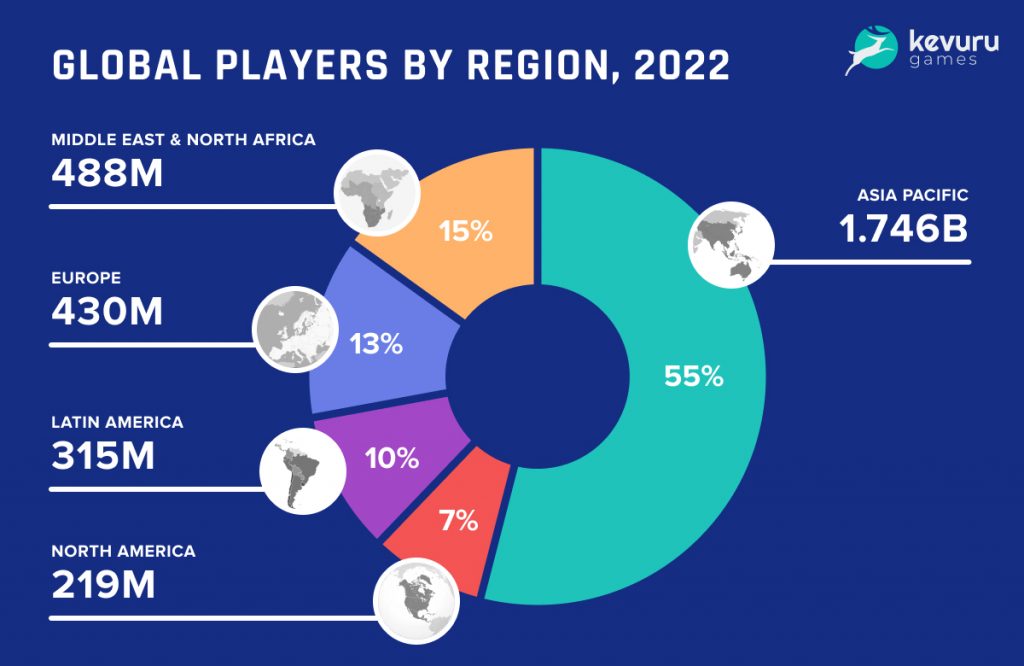
People easily part with money to experience vivid virtual impressions during quarantine. The Asia-Pacific region spends the most money on games: it accounts for $87.9 billion of total revenue, 45.8 billion of which comes from China.
The world market of computer and mobile games by the end of the year will reach $200 billion, following the Newzoo forecast. This is almost three times the market for music content and four times the world’s total film distribution.
By 2025, the market size will increase to $211.2 billion with an compound annual growth rate of 3.4% in 2020-2025.
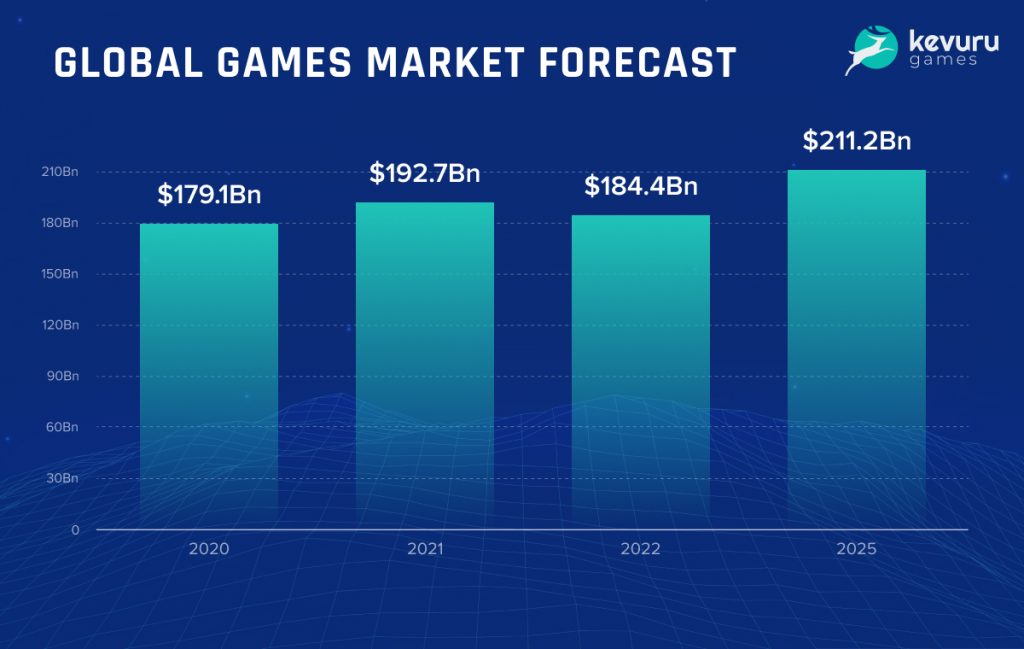
50% of the entire gaming industry’s revenue comes from mobile games. The main trend today is not one-time purchases, but attracting paid players who donate at one time or another to get loot boxes, characters, additional levels, etc.
According to Business of Apps, in 2022, games accounted for 38,3% of all app downloads, and in-game purchases accounted for 74% of all in-app purchases.
At the same time, in 2019, the time spent in front of a smartphone screen for the first time exceeded the time spent in front of a TV screen (by 8 minutes a day, with a total of just over 7 hours). In 2021, this difference increased to 30 minutes. Interestingly, the total screen time is not growing and is about 7 hours a day. However, back in 2014, for example, mobile devices took 2.5 hours a day, and TV – 4.5 hours.
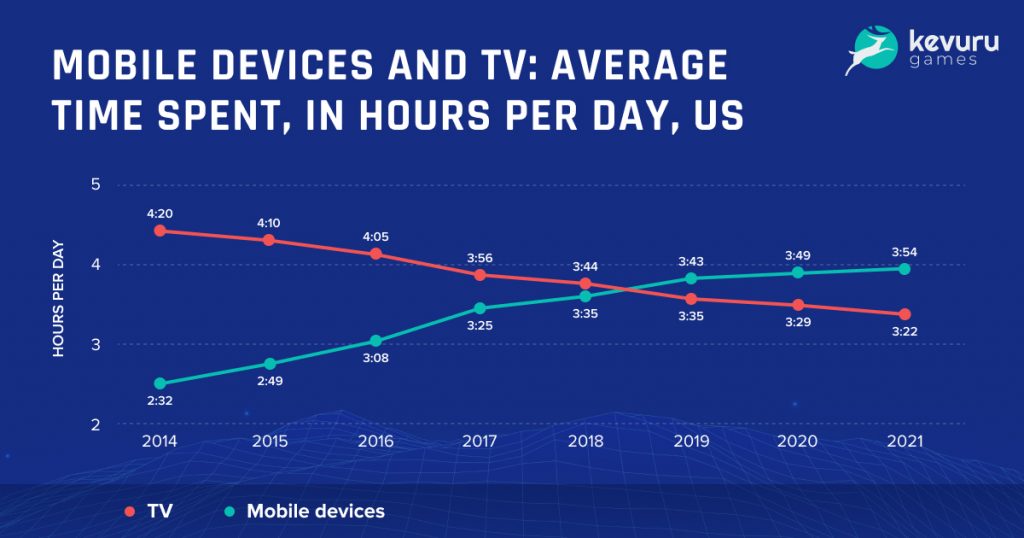
Large non-gaming companies began to worry about the growing influence of games long before the pandemic began. In 2019, Netflix CEO Reed Hastings said that he was far less afraid of his direct competitors Disney or Amazon than YouTube and the video game Fortnite from Epic Games.
Now the situation has become even more interesting, because people rushing about in search of entertainment are more likely to find it in an interactive game than in passive movie watching.
So, what upcoming gaming trends can we identify now? We have created a map to make it easier for you to navigate in our subsequent structural systematization of the most significant trends of the next year.
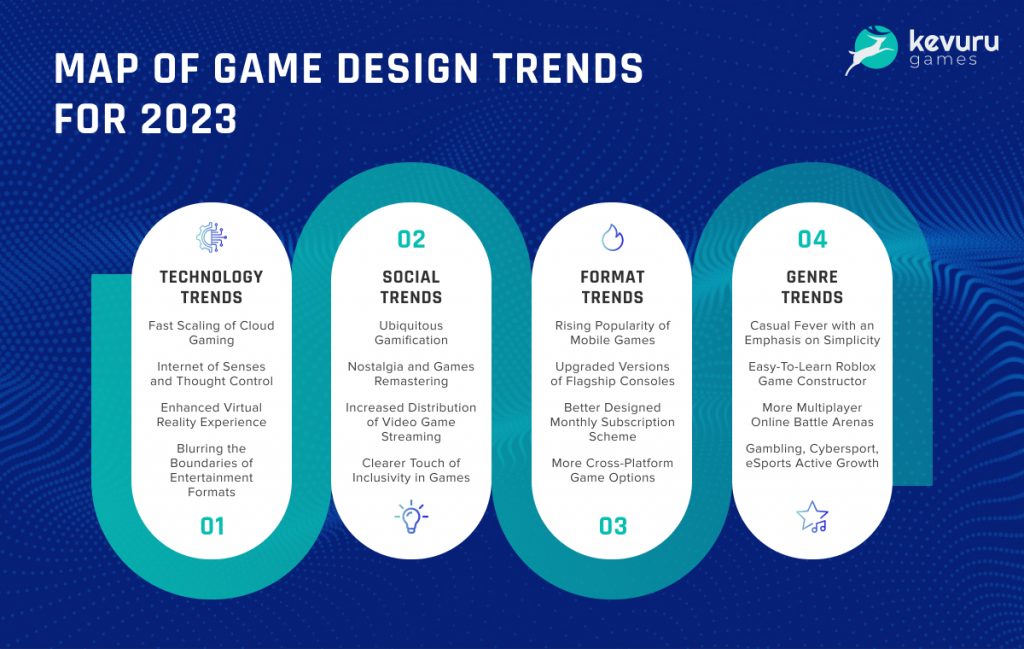
Technology Trends
State-of-the-art technological developments and innovations that are about to enter the market or already exist and are preparing for large-scale modification and expansion.
Fast Scaling of Cloud Gaming
Experts expect that the market for the priority trend of the gaming industry — cloud gaming or Gaming-as-a-Service — will grow to $450 million by 2023. This technology is already making games more democratic. Services like Google Stadia, PlayStation Now, or Playkey run resource-intensive applications without being tied to hardware capabilities. In the future, they will provide developers with creative freedom without technical restrictions:
- No expensive equipment. There will no longer be a barrier in the form of expensive equipment: anyone can embody their fantasies in creating games.
- New immersive games for everyone. A new class of games will appear, originally created for cloud standards. Unprecedented horizons will open for virtual worlds, including in VR format. Cities and even entire planets can be worked out to the smallest detail – it will be difficult to distinguish them from the real ones.
- Blurring the boundaries between genres. By pushing beyond the limits of hardware specifications, games will be able to blend multiple genres at the same time, or combine the most iconic features of many genres to provide an immersive experience.
- Development of virtual communities. An element of social approval of the player’s character will become important – virtual communities will increasingly resemble real ones. For example, the developers of Death Stranding introduced likes as a tool to reward the actions of other players, such as buildings or warning signs of danger.
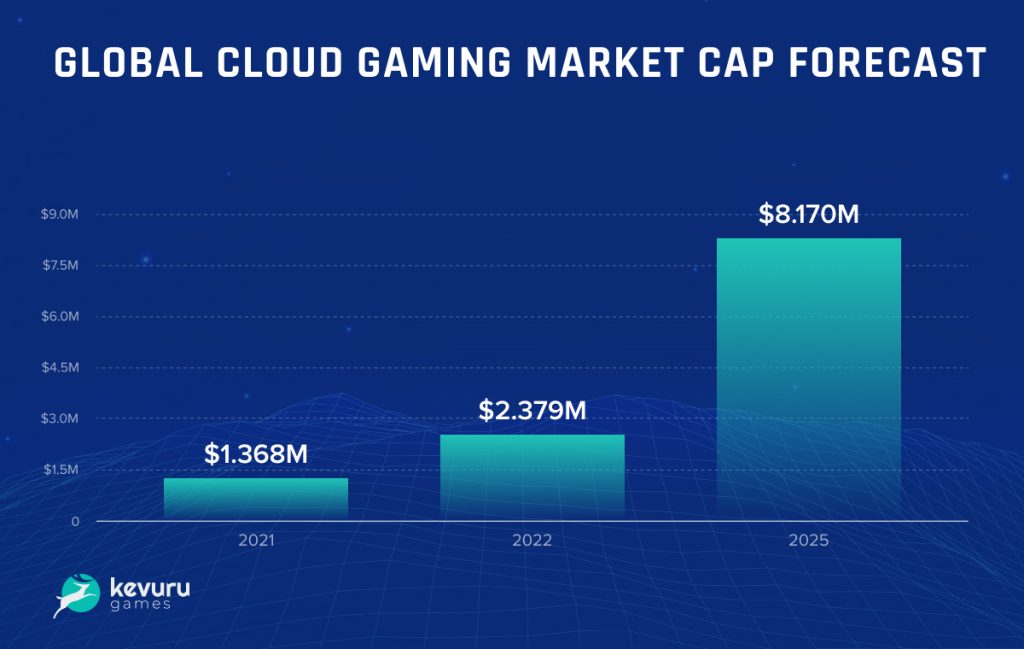
Players will experience new dimensions of freedom from hardware restrictions. The cloud gaming gives them the ability to outsource their computing needs to remote hardware. No need to download or install games. The only thing that is needed is the fast Internet. In 2023, there will be many more options for hassle-free online play.
The driver of cloud gaming development is the spread of 5G. This communication standard will increase the speed and make the transfer of large amounts of data from the cloud seamless. The technology will cause a surge of gamers who will play from their phone – there are already more than 2 billion such users, and thanks to 5G, their number will increase several times.
Related Content:
✔ 5 Most Exciting Gaming Technology Trends in 2023 [+ Special Bonus Trend That-Must-Not-Be-Ignored]
Internet of Senses and Thought Control
The control of the character will change: the development of neurocomputer interfaces will make it possible to control their actions by signals from the brain. Such devices already exist. Through the Emotiv EPOC device, you can work with software with the power of thought – for example, control drones using neurotransmitters. According to Ericsson experts, the technology will become widespread in this decade.
The mentioned 5G standard will allow using not only sight and hearing in games but all senses. We will see the Internet of Senses: digital sensors using artificial intelligence, and VR and AR will allow tasting the gaming universe – literally:
- Hearing and voice. Tuning the perception of the virtual world by ear will become more accurate. Ericsson believes that by 2035, players will be able to set their headphones to automatically translate from any language. There will also be an opportunity to choose the sound of the gamer’s voice – personalization will become even more detailed.
- Synesthesia. Synesthesia is an even greater field for experiments, which will be given by the Internet of Senses. Players will be able to listen to the red color of a traffic light or feel the roar of a game monster in their own skin.
- Digital taste and smell. This is another promising technology that more than half of Ericsson’s experts expect to see by 2035. The rapid urbanization of the world, where more than half of the population already lives away from nature, makes this development more than real.
Paradoxically, games can be a new way of interacting with nature. Imagine a VR walk in the woods where you can smell all the odors and taste virtual berries. Technology will blend the virtual and the real.
Enhanced Virtual Reality Experience
Virtual reality is already available to us, but not yet at the best level. Several gaming companies have already begun to improve their photorealistic graphics in console and PC games. Developers are steadily improving this technology to make it indispensable in the lives of gamers.
Demand for high-quality virtual reality is high: unable to experience the familiar sensations of everyday life, locked in a lockdown cage, people are turning their eyes to the modern possibilities of transferring to other realities.
October 2022 saw the launch of Quest Pro, the first in a new line of high-end VR headsets from Meta. The device is equipped with an updated Qualcomm Snapdragon XR2+ chipset, providing 50% more processing power than the Meta Quest 2. It also has eye and face tracking, full-color mixed reality transmission, and a host of other interesting features. And it’s already been confirmed that we’ll get another headset next year.
Blurring the Boundaries of Entertainment Formats
The difference between games and other forms of entertainment such as movies will be completely erased. New Unreal Engine 5 already produces a picture that is hard to distinguish from Hollywood. The actors’ virtual avatars become the heroes of Cyberpunk 2077 or Death Stranding: games are an interactive way of storytelling that will change the very drama and the relationship between viewer and writer.
The interactivity of virtual universes will allow the fourth wall to be finally destroyed. The viewer will determine the development of the plot and will become the director of their own productions within the game world thanks to streams. The definition of sport will also change: Millennials are already watching gamers play video games more often than regular sports matches. As the audience matures, eSports will become a familiar form of competition. It may even enter the Olympic disciplines.
The fact that games will not be tied to the platform thanks to cloud technologies will also affect our consumption. Users will pay for in-game content and the social side of games like community access, not the platform. It will be possible to enter the virtual world from any device with a screen and a 5G connection, from a smart refrigerator to smart watches.
Social Trends
How the gaming component is becoming a part of all spheres of society, video activities are spreading, and players’ gaming expectations are changing.
Ubiquitous Gamification
Games are no longer just entertainment. Virtual worlds are becoming a new platform for communication. People use them for different purposes.
| Hold working meetings | This has already been implemented in the cowboy game Red Dead Redemption 2 where employees preferred a warm campfire to a standard and boring Zoom call. Colleagues can get to the meeting point on horseback under the ominous howl of wolves. |
| Build university campuses | A group of Randolph students depicted their university campus using recognizable graphic blocks from a world-building video game Minecraft. |
| Teach lessons | Teachers have already added games to their arsenal. Geometry teacher Charles Coomber from San Diego conducted lessons in the VR offshoot of Half-Life. A video of one of these lessons was posted on YouTube. To date, it has gained over 500,000 views. |
| Arrange concerts | American rapper Travis Scott showed how to do this in the game Fortnite, drawing a concurrent audience of almost 13 million viewers worldwide, not counting Twitch and YouTube. |
To compensate for the lack of live communication, people are moving faster and faster towards the transition to game reality. Self-isolation only helps this process: universes of games like Fortnite are much more versatile and functional than Zoom or Skype. They have a wide range of personalization tools and allow gathering a huge audience. Surrounded by restrictions that prevent the full use of human reality, people happily plunge into virtual worlds where there are no restrictions.
In the future, games will also transform the education system. Of course, they will not replace the lessons entirely, but rather become an addition to them/ The skills learned in the games will be applied both at school and at work. For example, researchers from the University of Glasgow have found that games develop critical and reflective thinking, and also have a positive effect on the reaction. They even point out that games can help a person find a job. Unless, of course, one abuses the duration of gaming sessions.
Nostalgia and Games Remastering
Despite the technical superiority of the new consoles, they cost little without a library of games. Next-generation gaming is a matter of the future. In the meantime, many players under 35 are especially fond of old games. Some even use Playstation 3. The nostalgia trend will continue into 2023.
In order for players to be able to play old games, it is necessary to maintain the possibility of backward compatibility with previous generations of consoles and remastering of old games for which there is practically no suitable hardware. A return to the basics has already shown its relevance in the film industry: Disney has benefited immensely and high box office returns from transforming classic cartoons into live-action films.
Increased Distribution of Video Game Streaming
Game streaming is taking over the industry more and more. With the advent of one-click live game streaming, open-source capture and broadcasting tools, the number of hours spent watching game video has skyrocketed. Competitive games create unique gaming experiences that are actively shared and watched by millions. It engages people more than sporting events and revives interest in old classics like Heroes of Might and Magic III.
Forced to stay at home, people are much more actively browsing the communities of the games they are interested in looking for interesting tricks, easter eggs, tips, and just examples of a beautiful walkthrough. Therefore, streaming goes beyond classic YouTube and extends to social networks, personal blogs, and other platforms such as Twitch, Periscope, and others. People are joining streams of their favorite franchises not only on PCs, but also on smartphones, tablets and even TVs, showing a steady shift from standard TV content to bespoke gaming content.
Related Content:
✔ Best Games to Stream on Twitch in 2022: Top Titles for Professionals & Beginners
Clearer Touch of Inclusivity in Games
Video games are a great way to raise the awareness of all kinds of audiences about the issues of racism, sexism, and homophobia, many of which have literally blown up this year. The Sims 4 can be considered one of the most inclusive games in the industry today because it gives players the freedom to create their Sim with any skin color, nationality, or religion.
Games that allow you to customize characters down to the smallest detail are popular with gamers. Therefore, the developers keep it in service. The trend towards inclusiveness will continue as the world becomes more receptive to different cultures and preferences.
With the diversity and inclusiveness of games, it becomes much more obvious to players that they are open to the realization that everyone is different, which is great. Diversity may become more prevalent in video games as sectors of the entertainment industry move towards equality.
Format Trends
The evolution and potential of gaming platforms, in-game changes in receiving bonuses, and uniting players with different hardware.
Rising Popularity of Mobile Games
About half of smartphone users play games. The total number of mobile players worldwide is about 2.6 billion. The largest category of players are people from 25 to 34 years old.
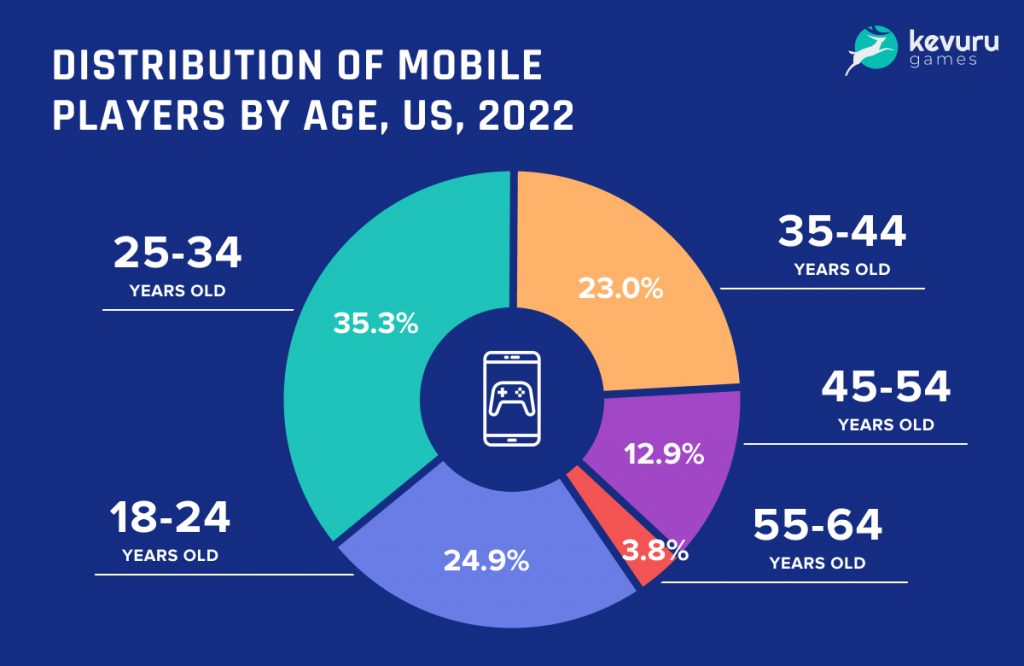
So it’s no secret that one of the biggest changes in the gaming industry over the next year will be the continued expansion of mobile games. This helps to increase the potential audience through the proliferation of smartphones and the ease of getting started. People love to play mobile games because they are virtually always with them. Therefore, developers will continue to create related products.
Major console and PC game makers are also releasing their games in a mobile version to meet the demands of the market. An example of such a transition is the long-awaited Call of Duty: Mobile. By moving into the mobile segment, the franchise has managed to reach a huge number of new players: over 300 million downloads since its release in October 2019 speaks for itself.
Previous trends such as Fortnite-style battle royales have fueled mobile gaming. They have proven that the gaming experience on mobile devices is in no way inferior to the desktop. People only use their smartphones and do not need to buy expensive equipment.
In addition, Epic Games has been a pioneer in demonstrating the ability to break the monopoly of world-famous corporations. Abandoning the Apple Store and Google Play, Epic has listed its iconic Fortnite game on its own store for a much lower fee and no limits.
Upgraded Versions of Flagship Consoles
Another trend in the video game industry is the release of additional updates for consoles every year or two. Previously, when the console was on sale, players no longer waited for further updates. These units can stay on the market for up to ten years without any changes.
However, that all changed after hardware manufacturers such as Sony, Microsoft, and Nintendo released incremental console updates for their products. Every year or two, a new version of the current gaming system is released, and features like extended battery life are the main reason people buy upgraded consoles.
It was hard not to pay attention to the fall in sales of PS4 and Xbox One consoles in 2019. The reason for this was the completion of their cycles and the need for new generation technologies. Although the good performance of the Nintendo Switch somewhat slowed down the overall decline in console sales, the downward trend continued until the next generation of consoles hit the market.
So far, PlayStation 4 remains the most popular console among gamers. Launched in November 2020, the PlayStation 5 sold 22.95 million units in 23 months, while the PS4 sold 27.01 million units. A total of 117.01 million PS4 units have been sold to date.
As for the Xbox Series X, which launched at the same time as its rival PS5 at the end of 2020, it sold 18.16 million units in 23 months, slightly losing market share to its rival (57.2% vs. 42.8%). In addition, console supply issues due to chip shortages are less of an annoyance for Xbox, while Sony’s PS5 is still in short supply at most retailers.
Pro versions of the current flagship consoles, PS5 and Xbox Series X, will receive their mid-generation upgrade in 2023.
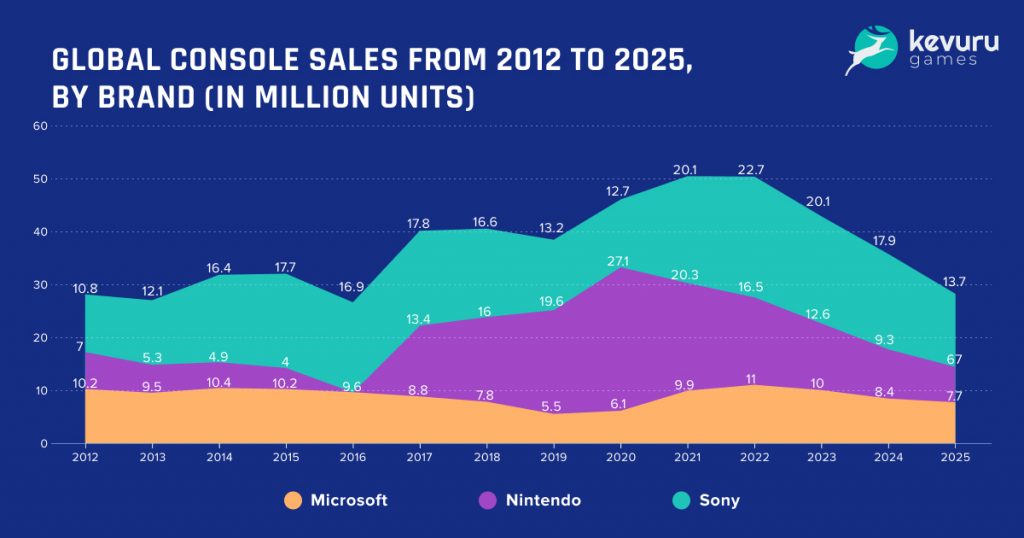
Better Designed Monthly Subscription Scheme
Artfully woven into in-app purchase models, free-to-play games that entice passionate gamers to purchase coveted items as soon as possible are likely to reach a new level of monetization. This is a monthly digital subscription.
A longstanding classic technique widely used for music and video streaming platforms can be applied to video games as well. The subscriber will be able to get exclusive items, premium passes, and other goodies that are not available to players without a subscription.
There have already been attempts to implement a subscription system, for example, in the games Mario Kart Tour and PUBG Mobile. But its limitation in the form of the only daily collection of bonus currency, and in some cases even the absence of any value at all, pushed players away.
Players note that they would love to subscribe if the game was then cleared of ads, loot boxes, and in-game purchases. This would allow players to simply enjoy the game with truly premium access, guaranteed by a monthly installment. At the same time, of course, there should be a free version of the game with ads and in-app purchases.
Subscription services may be relevant for fans of hardcore genres that require a high level of engagement and a lot of game hours. Casual and hypercasual gamers are definitely not the right audience for a monthly subscription. They often use games as an opportunity to pass the time on the road or while waiting for an order. Plus, casual games are not a genre where you can come up with really worthy features to create a subscription base.
More Cross-Platform Game Options
The popularity of cloud gaming has led to an increase in the capabilities of gaming platforms: they now offer both full and partial cross-platform support. It’s a boon for gamers as many of them are tied to only one platform.
The growing demand for multiplayer games dictates the need to connect players across multiple consoles and PCs. The developers were faced with the need to introduce new solutions and search for crossplay opportunities. So far, this is quite difficult due to the fact that manufacturers of different consoles often seek to isolate their community.
Despite some hurdles, mainstream games are now getting cross-platform support and this trend is likely to grow. People who play Fortnite should not experience technical difficulties due to their opponents using different hardware.
Genre Trends
Key gaming genres that are gaining momentum in 2022 and extending their influence into 2023, as well as the prospects for gambling and eSports.
We have already mentioned that 2020 was marked by an increased interest in online multiplayer games and the growing influence of the mobile segment. The search for society and the desire to spend time with real people, albeit at a distance, came to the fore. Given the pandemic uncertainty of 2021, the genre distribution of trends remained the same.
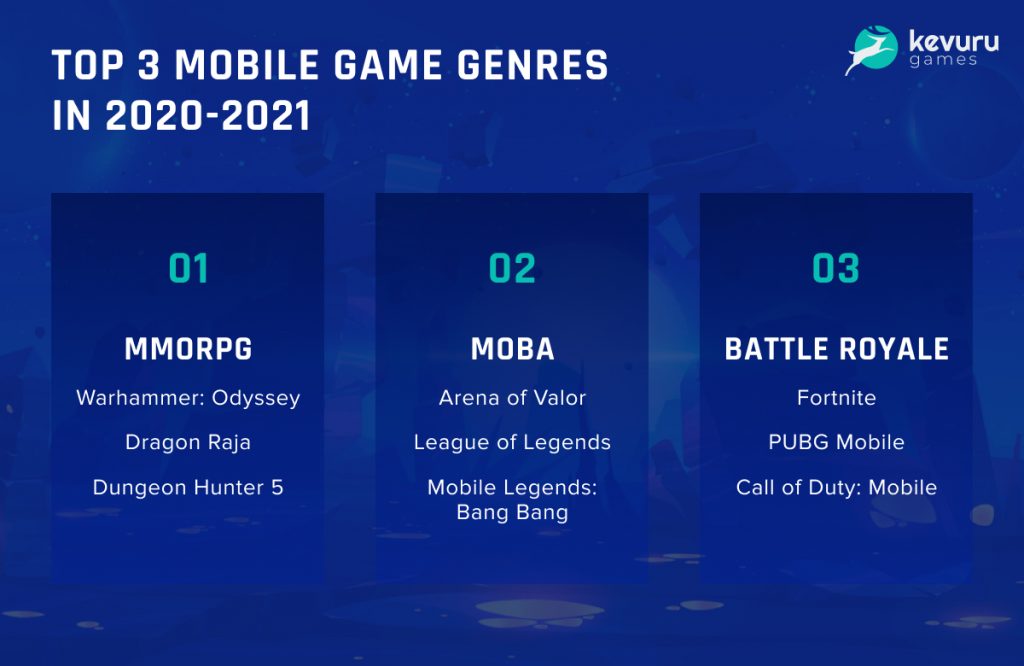
However, in 2022, user preferences for mobile genres have undergone significant changes. The focus has shifted towards hypercasual games of such subgenres as interactive novels, puzzles, simulation, and everything that includes their combinations.
Related Content:
✔ About Profitable Hyper Casual Games: Design Tips, Rates, and Upcoming Trends
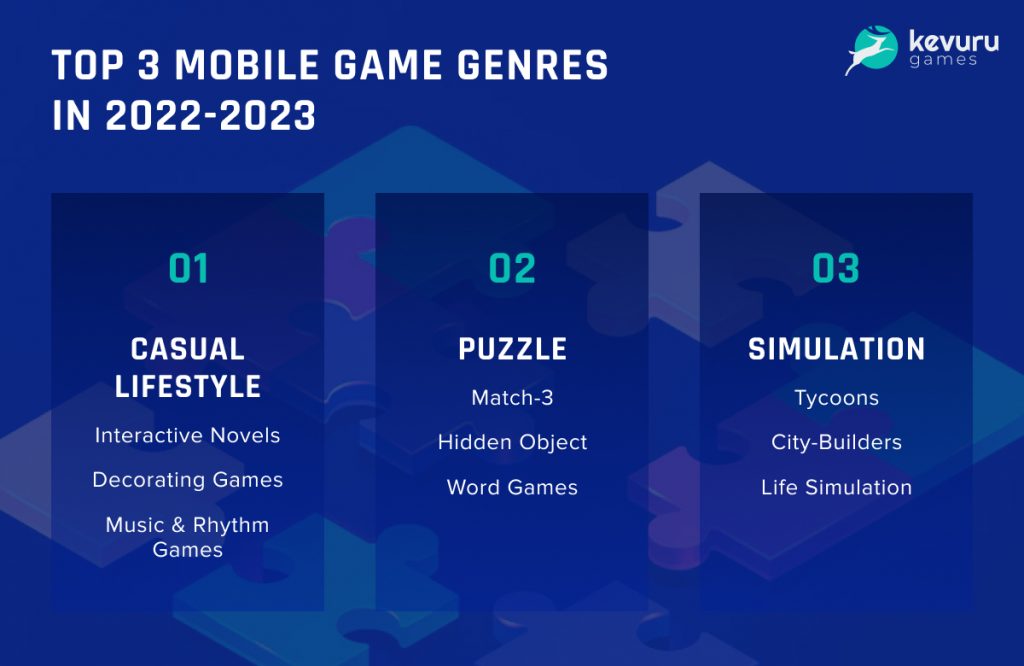
However, despite new favorites, MOBA remains the top-grossing gaming genre of 2022 thanks to Honor of Kings, the world’s most-played mobile MOBA with 100 million daily players. That is why we predict that MOBA will still remain on the throne, surrounded by “affected” hypercasual games. But let’s talk about everything in order.
Casual Fever with an Emphasis on Simplicity
The creeping expansion of casual games, which gradually pushed multiplayer games out of the top of the rankings, reached its peak in 2022. No longer forced to stay locked up at home, people have returned to their favorite mobile games with short gaming sessions and simple, unobtrusive gameplay.
According to a study by ad Intelligence & analytics platform Apptica, apart from Honor of Kings with its insane popularity in China, the top-grossing game in Q2 2022 was again the legendary match-3 puzzle game Candy Crush Saga, which earned $122 million on Android and $85.2 million on iOS.
It was followed by an arcade with casino elements Coin Master with $99.2 million, and Roblox closed the top three with $68.1 million. At the same time, Roblox is not a game, but an online gaming platform and game creation system that allows any user to create their own games and play games created by others, covering a wide range of genres.
Therefore, in addition to the continuing trend of the popularity of casual games, it is Roblox who enters the arena unexpectedly for everyone.
Easy-To-Learn Roblox Game Constructor
A real black swan of 2022, Roblox is not new to the gaming market, having been released way back in 2006. But after the pandemic, the platform found a second life, cunningly put on the name of an almost-metaverse, and successfully became the third top-grossing mobile project of 2022.
Initially conceived to involve children in the creation of games, the platform has become much more widespread among the adult audience. Aspiring game developers use the Roblox platform to quickly get feedback and improve their games. It is convenient that Roblox is available not only on mobile platforms, but also on Windows, macOS, and even Xbox One.
Some statistics: Roblox has about 50 million daily users (57.8 million in September 2022) and 202 million monthly active users worldwide. The growing popularity is fueled by the simplicity of the platform and its metaverse capabilities. Even an absolute beginner will be able to assemble a simple game using its tools as a constructor. And the internal currency Robux allows everyone to buy digital items of real brands right in the games created in Roblox.
More Multiplayer Online Battle Arenas
MOBA games are a mixture of real-time strategy and action. In multiplayer battle arenas, the player controls one character – a hero or champion from the available roster, picking up a unique set of skills and abilities. This can be a magician, warrior, knight, or representative of another profession. The mobile version of the genre differs from the computer version (League of Legends or DOTA 2) because it does not reflect the same depth of mechanics and strategy. Mobile devices are limited in processing power, display size, and input options. However, this does not stop millions of smartphone users from enjoying their favorite games.
Teams of 3 or 5 players face off against each other for resources, objects and map control. The player needs to have fast fingers, a lively mind and a lot of patience to play MOBA games.
Until 2016, this genre broke popularity records, but Battle Royale appeared and took some of the glory for itself. MOBAs are no longer as popular as they once were, especially among the mainstream audience and casual players. But they’re still holding strong thanks to the undefeated Tencent’s Honor of Kings, the highest-grossing mobile game worldwide, which has grossed nearly $4.5 billion worldwide on the App Store and Google Play since its launch in October 2015. With about $200 million a month in player spending, this MOBA is unmatched in the world and keeps its genre afloat.
Gambling, Cybersport, and eSports Active Growth
The growth of loyalty and the legalization of online casinos contributed to the development of the gambling industry. At the same time, the iGaming business is in line with the previous trend: almost every online casino has a mobile application or supports mobile games through mobile browsers.
The evolution of slot machines is also interesting. If earlier they were considered games for singles, then with the advent of multiplayer options, people can take part in the game at the same time, gathering in teams and watching each other’s game process. In 2021, players often get together to spin the reels and try their luck.
Call of Duty is an example of an esports game that is very popular with bookies. Activision, the game’s publisher, has gone one step further and created the Call of Duty Championship League, which shows how big name brands are taking advantage of online technology. While they may not be promoting sports betting themselves, the fact that they are so heavily involved in eSports now speaks volumes about what to expect next year.
During the pandemic and the year after, the inability to attend live sporting events spurred people’s interest in sports betting, predictions, and projects like Second Leagues. While you can watch your favorite teams play online, players have the opportunity to bet and experience the full range of thrills. The habit of watching sports events online has continued after the pandemic.
If in 2019, the audience of people who watched sports events at least once a month was about 400 million, then by the end of 2025, it is expected to grow to 684 million.
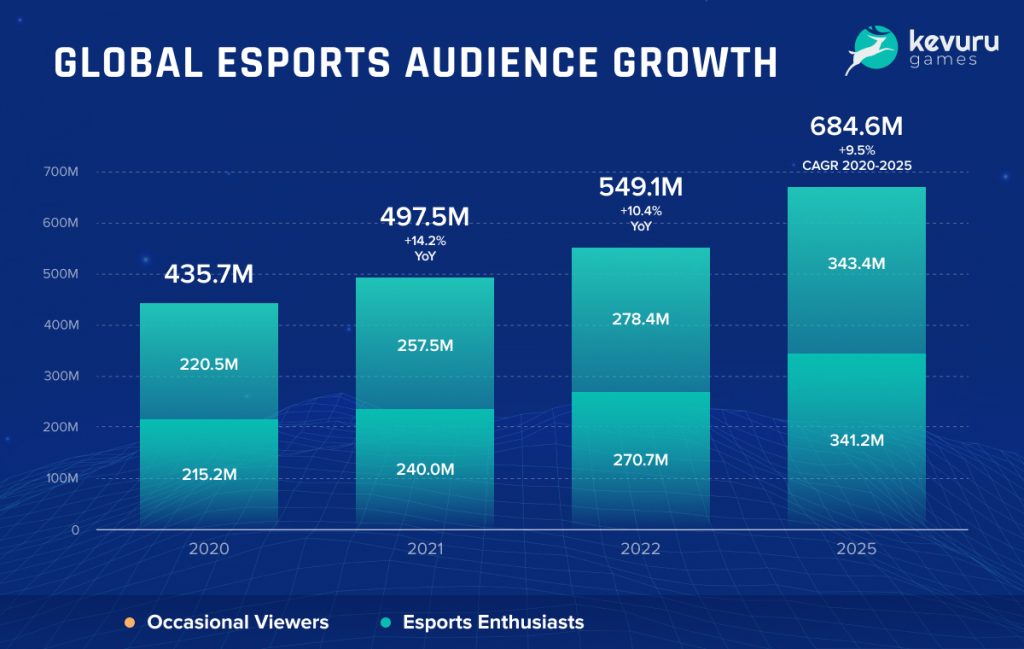
Game Potential of the New Year: Towards Latter-Day Experience
2020 has been a special year for the gaming industry: a sudden surge of increased interest in games has shown who was more ready for this and not only managed to adapt, but also benefit from it. 2021 and 2022 continued the trend of rapid gaming development, putting forward new favorites and unfolding technological innovations.
The reasons for the success of the gaming industry lie both in psychological and economic terms. On the one hand, during a period of turmoil, people subconsciously try to force out pressing problems and switch to various kinds of entertainment. With no other options for entertainment, people are moving into virtual reality.
The coronavirus has changed consumer preferences in favor of technologically advanced services. As such, there is still plenty of room for growth in online gaming revenue and online entertainment spending. Part of the new, re-educated audience of Internet services will remain with them forever.
And while the gaming industry is developing in its own way, we at the Kevuru Games company continue to work diligently on new projects designed to brighten up the expectation of getting rid of a dangerous new threat. To create without limits, skillfully balancing the target and economic expectations of customers, player preferences and new trends — that’s why we have gathered in a close-knit, passionate, and inspired team.
The gaming industry will go through a lot of challenges in the coming year. As game lovers, we are all here to witness all of its changes because they really matter to us. Stay safe and play games — next year promises to be interesting.
Kevuru Games is a game art and development company that implements mind-blowing projects for anyone looking to shake up the gaming space. We work with major world-renowned game video companies such as Epic Games, EA, and Lucasfilm, as well as enthusiastic indie studios and solo developers. It is important for us not only to fulfill the client’s requirement but also to make the project shine like a new bright star on the gaming horizon. Drop us a line to find out how we can help bring your idea to life.
Let’s create beyond the limits together!










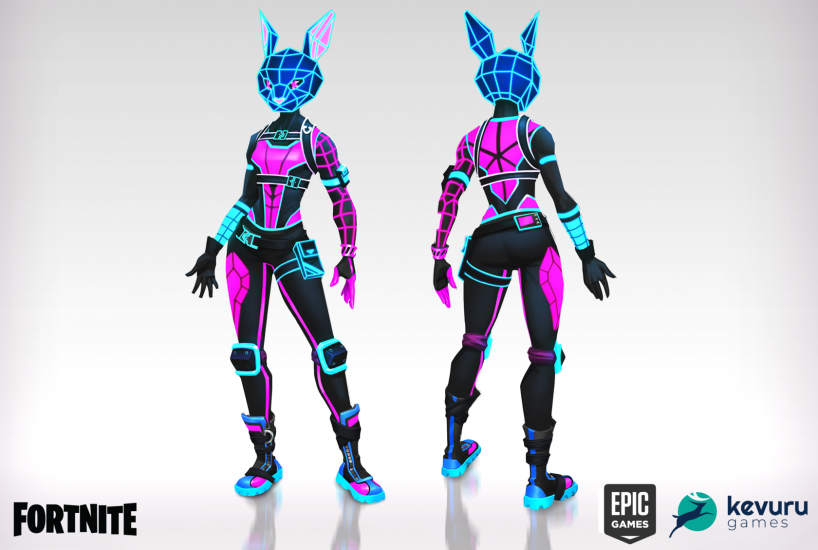






![Indie Game Development: Guide to Revenues, Most Profitable Genres & Monetization [+10 Best Indie Games 2024]](https://kevurugames.com/wp-content/uploads/fly-images/11949/indie-pre-138x138.jpg)